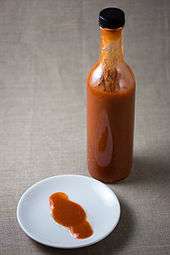Harissa
Harissa (Arabic: هريسة harīsa, from Maghrebi Arabic) is a Tunisian hot chili pepper paste, the main ingredients of which are roasted red peppers, Baklouti (بقلوطي) peppers or serrano peppers, spices and herbs such as garlic paste, caraway seeds, coriander seeds, cumin and olive oil to carry the oil-soluble flavors. Rose harissa, made with rose petals, is also made.[1]
| Alternative names | هريسة |
|---|---|
| Type | Paste |
| Place of origin | Tunisia |
| Region or state | Maghreb |
| Main ingredients | Red peppers |
| Ingredients generally used | Baklouti pepper |
History
As in European cuisine, chili peppers were imported into Maghrebian cuisine by the Columbian Exchange,[2] presumably during the Spanish occupation of Tunisia between 1535 and 1574.[3]
Tunisia
Recipes for harissa vary according to the household and region. Variations can include the addition of fermented onions or lemon juice. Prepared harissa is sold in jars, cans, bottles and tubes. Harissa is sometimes described as "Tunisia's main condiment",[4] even "the national condiment of Tunisia",[5] or at least as "the hallmark of Tunisia's fish and meat dishes".[6] In Tunisia, harissa is used as an ingredient in a meat (poultry, beef, goat, or lamb) or fish stew with vegetables, and as a flavoring for couscous. It is also used for lablabi, a chickpea soup usually eaten for breakfast.
In 2006, the Tunisian production of harissa was 22,000 tonnes, incorporating about 40,000 tonnes of peppers.[7] Tunisian harissa is often made with chilis grown around Nabeul and Gabès, which are relatively mild, scoring 40,000–50,000 on the Scoville scale.[8]
Algeria
In Algeria, harissa is commonly added to soups, stews, and couscous.[9] Harissa paste can also be used as a rub for meat[10] or eggplants.[11] Another significant producer is Algeria's Annaba Province,[12] which is also a significant consumer.[13] According to cookbook author Martha Rose Shulman, premade harissa tastes rather different from that which is served in Tunisian and expatriate restaurants.[14]
Morocco
Moroccan cuisine has also adopted harissa, using it as a side condiment for tagines, or sometimes mixed into dishes. Tunisia is the biggest exporter of prepared harissa.[15]
Filfel chuma
Filfel chuma (Hebrew: פלפלצ'ומה), also spelled pilpelshuma, literally "pepper garlic", is the typical chili sauce of Libyan Jewish cuisine which is very similar to the harissa.[18] It comes from the Libyan cuisine, where it is known as maseer (Arabic: المصير or مسّير حار mseyer).[19][20] It is also known by other names such as filfil mukhalal (فلفل مخلل) and filfil makbos (فلفل مكبوس).[21] It is made from powdered sweet and hot peppers and crushed garlic. Other ingredients, such as ground caraway seeds, cumin, lemon juice, and salt are sometimes added.[18]
It serves as a condiment and as an ingredient in dishes such as salads, meat, fish, legumes and rice, and egg dishes such as shakshouka.
See also
References
- Pip Sloan (1 October 2019). "Six of the best harissa pastes, tried and tested". The Daily Telegraph.
- Morse, Kitty; Lucy Malouf (1998). Artichoke to Za'atar: Modern Middle Eastern Food. U of California P. p. 66. ISBN 978-0-8118-1503-1.
- Gil Marks (2008). Olive Trees and Honey: A Treasury of Vegetarian Recipes from Jewish Communities Around the World. "Northwest African Chili Paste (Harissa)": Wiley. ISBN 0-544-18750-4.
- Linda Civitello (2011). Cuisine and Culture: A History of Food and People. John Wiley & Sons. p. 244. ISBN 978-1-118-09875-2.
- Jessica B. Harris (1998). The Africa Cookbook: Tastes of a Continent. Simon and Schuster. p. 137. ISBN 978-0-684-80275-6.
- Marshall Cavendish (2006). World and Its Peoples. Marshall Cavendish. p. 1282. ISBN 978-0-7614-7571-2.
- Oxford Business Group. The Report: Tunisia 2008. Oxford Business Group. p. 195. ISBN 978-1-902339-93-1.
- Donna Wheeler; Paul Clammer; Emilie Filou (2010). Tunisia. Lonely Planet. p. 53. ISBN 978-1-74179-001-6.
- Sari Edelstein (2010). Food, Cuisine, and Cultural Competency for Culinary, Hospitality, and Nutrition Professionals. Jones & Bartlett Publishers. p. 345. ISBN 978-1-4496-5968-4.
- Fayed, Saad. "Flank Steak with Harissa". About.com. Archived from the original on 2009-06-08. Retrieved 2009-08-02.]
- "Baby Eggplant with Harissa and Mint". Ashbury's Aubergines. Retrieved 2009-08-02.
- Oxford Business Group (2008). The Report: Algeria 2008. Oxford Business Group. p. 230. ISBN 978-1-902339-09-2.
- Ken Albala (2011). Food Cultures of the World Encyclopedia. ABC-CLIO. p. 7. ISBN 978-0-313-37626-9.
- Martha Rose Shulman (2014). The Simple Art of Vegetarian Cooking: Templates and Lessons for Making Delicious Meatless Meals Every Day. Rodale. p. 254. ISBN 978-1-62336-130-3.
- Tunisian Harissa Export cepex.nat.tn Archived September 6, 2009, at the Wayback Machine
- Jane Hughes (2013). The Adventurous Vegetarian: Around the World in 30 Meals. New Internationalist Publications, Limited. p. 182. ISBN 978-1-78026-124-9.
- Bruce Kraig; Colleen Taylor (2013). Street Food Around the World: An Encyclopedia of Food and Culture. ABC-CLIO. p. 200. ISBN 978-1-59884-955-4.
- Gur, Jana; (et al.) (2007). The Book of New Israeli Food: A Culinary Journey. Schocken Books. pg. 295. ISBN 9780805212242
- How to make Libyan maseer
- North African hot recipes
- How to prepare mseyer in the Libyan cuisine
External links
| Look up harissa in Wiktionary, the free dictionary. |
- Tunisian Harissa Recipesource.com
- The Japanese Discover Tunisian Harissa allvoices.com
- Tunisian Harissa Recipe
- Harissa Recipe Foodista
- Filfel Chuma recipe
